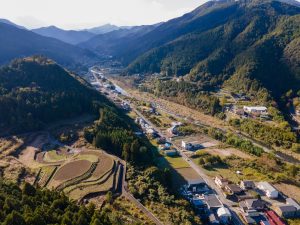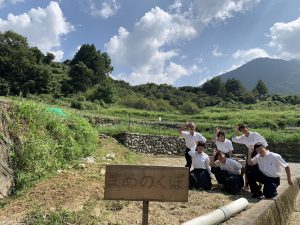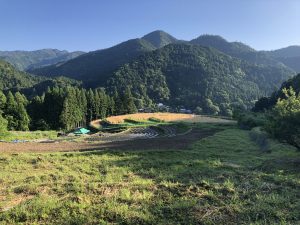神山発「まめのくぼプロジェクト」 / Kamiyama’s “Mamenokubo Project” /
中国四国地域の耕作放棄地面積は、経営可能な耕地の約20%(※1)に迫ろうとしており、全国平均と比較するとかなり高めで推移している。この傾向は、四国の山間地域では特に顕著で、人口減少・過疎とあわせ、重要な地域課題である。

(※2)
この課題に向き合い活動を続けているのが、徳島県立城西高校神山校「まめのくぼプロジェクト」である。町内の谷地区の段畑、通称「まめのくぼ」を地域の方から借り受けて栽培を始めたのが2018年。当初は、70年以上神山で継がれている「神山小麦」の栽培からスタートしたそうだ。

集落を通り抜けた急斜面に広がる段畑は管理面積 約9,000㎡、耕作面積 約2,100㎡に及ぶ。実践の場は、毎年、さまざまな作物が栽培されており、何を植えるかは、生徒同士の話し合いや検討の中で決まる。取材に訪れた日は、ちょうど綿の花が開花していた。小麦やソバの栽培とともに、お茶やビワも植栽されている。
また、中山間地においては、獣害対策は必須、植栽地の周囲には電気柵がはりめぐらされている。ここではシカとの共生もテーマとなっている。さらに、耕作放棄地を耕地として再生し維持するために、栽培技術の習得や野生動物から作物を守る方法、段畑を維持するための石積みの補修など、やらなければならないことは、沢山ある。それに加えて、有機JAS登録や生物多様性認証にもチャレンジしており、ここはまさに学びと実践の先進地といっても過言ではない。

(※2)
放棄された農地を再生することが「大変」なのは間違いない。しかし、このプロジェクトに関わる生徒からは、「大変」以上に「まめのくぼが好き」「楽しい」「将来農家をやりたい」という感想や夢を沢山聞くことができた。その原動力は何なのだろう。先輩から引き継いだこと、新たな挑戦とやりがい、地域内の人に知ってもらおうと始めた「まめのくぼのつどい」など、そこには、紛れもない生徒の本気があり、それを受けとめて返してくれる地域の懐の深さ・温かさを実感し、そこにヒントがあるのではと感じた。
もっとみんなに知ってほしい。生徒の思いが地域の力となって、「まめのくぼプロジェクト」の発信は続く。
※1:中四農政局資料https://www.maff.go.jp/j/council/seisaku/nousin/bukai/h27_chiho_kondan/chushi/pdf/siryou_2.pdf
※2:写真提供協力(徳島県立城西高校神山校)
Kamiyama’s “Mamenokubo Project”
The area of abandoned farmland in the Chugoku-Shikoku Region is approaching about 20% of the total manageable arable land (※1), which is significantly higher than the national average. This trend is particularly pronounced in the mountainous areas of Shikoku, making it a critical regional issue alongside population decline and rural flight.

(※2)
The “Mamenokubo Project” at the Kamiyama Branch School of Tokushima Prefectural Jyosei High School is actively taking on the challenge. It began in 2018, when students borrowed a terraced field in the Tani district, known colloquially as “Mamenokubo,” from the local residents. Initially they cultivated “Kamiyama Wheat,” a variety of wheat which has been grown in Kamiyama for over 70 years.

The terraced fields, spreading over the steep slopes outside the village, have a management area of about 9,000 m2 and a cultivation area of about 2,100 m2. Every year, students grow various crops, deciding what to plant through mutual discussion and careful deliberation. The day I visited, the cotton flowers had just come into bloom, and in addition to wheat and buckwheat, they were also growing tea and loquats.
In the mountains, countermeasures to prevent damage from wild animals are vital, so the field is surrounded by an electric fence. Coexistence with deer is also one of the themes of the project. Furthermore, reclaiming and maintaining abandoned farmland involves a mountain of work, from learning farming techniques and how to protect crops from wild animals, to repairing the stonework supporting the fields. On top of that, they have obtained JAS organic certification and Tokushima’s biodiversity certification. It wouldn’t be an exaggeration to say this place stands at the forefront of applied learning.

(※2)
There is no question that reclaiming abandoned farmland is difficult. However, the students that I’ve spoken to involved with this project don’t seem to mind. The vast majority told me things like, “I love Mamenokubo,” “It’s fun,” and “I want to be a farmer in the future.” What is it that drives them? Is it a sense of duty to continue what they inherited from their seniors at school? A feeling of accomplishment from trying new things? The “Mamenokubo Meeting” they started to spread the word about what they’re doing? Or is it the profound depth and warmth of the community that accepts and responds to their unmistakeable efforts? That, I believe, may be the key.
I hope more people will learn about the students’ dedication, which is becoming a source of strength for the region, and that the “Mamenokubo Project” continues to spread its message.
※1: Chugoku-Shikoku Agricultural Administration Bureau document
※2: Photos courtesy of Tokushima Prefectural Jyosei High School Kamiyama Branch School
“Mame no kubo 项目”
中四国地区的撂荒耕地面积已接近可耕地总面积的20%,远高于全国平均水平。这一趋势在四国的山区尤为明显,人口减少和过疏化问题交织,使其成为该地区的重要课题。

面对这一挑战并持续开展相关活动的是德岛县立城西高中神山校的“Mame no kubo项目”。该项目始于2018年,最初由学校向当地居民租借镇内谷地区的梯田——通称“Mame no kubo”进行耕作。最初,他们从种植在神山地区传承70余年的“神山小麦”开始。

梯田位于穿越村落的陡峭坡地之上,管理面积约9,000平方米,可耕种面积约2,100平方米。每年,学生们都会种植各种作物,并通过讨论和研究决定具体种植品种。采访当天,正值棉花盛开。除了小麦和荞麦,这里还种植了茶树和枇杷等农作物。
在山区农业中,防范野生动物侵害是不可或缺的环节,因此,种植地周围设置了电围栏。如何与鹿共存也是该项目的一大主题。为了复耕并维持这些撂荒地,学生们不仅要掌握农作物种植技术,还要学习如何保护作物免受野生动物侵害,并进行梯田石墙的修复等工作。此外,他们还挑战了有机JAS认证和生物多样性认证。这里不仅是学习的场所,更是实践的前沿基地。

毫无疑问,复耕撂荒地的过程是“艰难”的。然而,参与该项目的学生们却纷纷表示,他们的感受远不止“艰难”,更多的是“喜欢Mame no kubo”“很有趣”“未来想成为农民”等积极的想法和梦想。那么,这股动力来自何处?从前辈手中接过的经验、新的挑战及其意义、为了获得本地人的理解而开展的“Mame no kubo集会”、还有学生们的毫无保留的认真、接受并回馈地方的包容与温暖的真实情感等,想必在这些当中便有答案。想要让更多的人了解这个项目;让学生的想法成为地域的力量,有关“Mame no kubo项目”的信息发布仍在持续。



